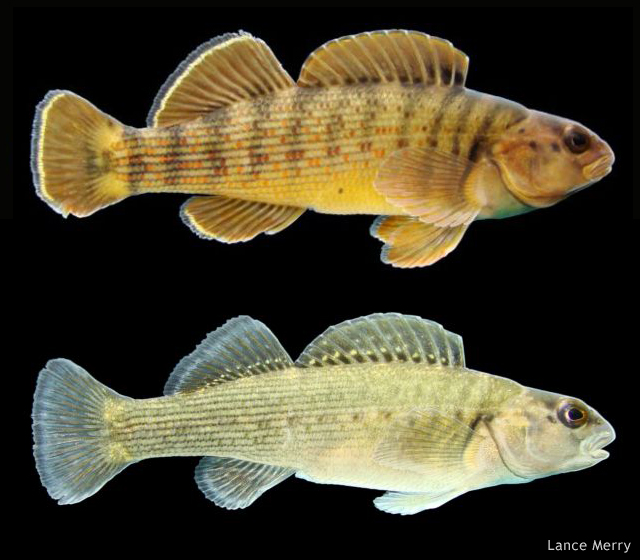Bluebreast Darter
(Etheostoma camurum)

Bluebreast darters are an indicator of good water quality and stream habitat. At one time they had become quite rare in Ohio. However, as a result of improved water quality they have made an impressive come back in much of their historical range in the state. To the left are photos of both male (above) and female (below) bluebreast darters
Description
The bluebreast darter has a rather blunt snout and 7-10 dark saddles over its back. The narrow spaces between these saddles are much lighter colored than the rest of the fish. They also have 8-12 vague vertical bars along their side. These are most visible closer to the tail. Bluebreast darters have many thin horizontal stripes along their side which are also more visible as they approach the tail. The outer edge of their fins has a dark margin followed by a thin white line just inside that dark outer margin. The first dorsal fin has a dark blotch on the webbing between the first 2-3 spines near the base of the fin. The closely related Spotted Darter lacks the dark margin to the fins, has a pointed snout, and smaller eyes. Male bluebreast darters have numerous small round red spots scattered along their sides. They also have an orange patch on their lower sides and a blue throat and breast. Female bluebreast darters lack the red spots, orange patch, and the blue throat and breast are also lacking or much less vivid in color. Additionally, females have some dark spots along their sides that are less numerous, less uniform in shape, and larger than the red spots of the males.
Habitat and Habits
Bluebreast darters are found in medium to large streams and rivers only in the Ohio River drainage within Ohio. At one time they had become quite rare in the state and were only found in limited portions of the Muskingum and Scioto River drainages. Fortunately, as a result of improved water quality, the bluebreast darter has made an impressive recovery in Ohio. They can now be found in every major tributary to the Scioto River from Columbus to the Ohio River. They have also made a similar expansion in the Muskingum River drainage.
Reproduction and Care of the Young
Bluebreast darters spawn in June and July. They bury their eggs in gravel in fast flowing riffles. Males guard a small territory around the spawning site until the eggs hatch. After the eggs hatch no further parental care is given.